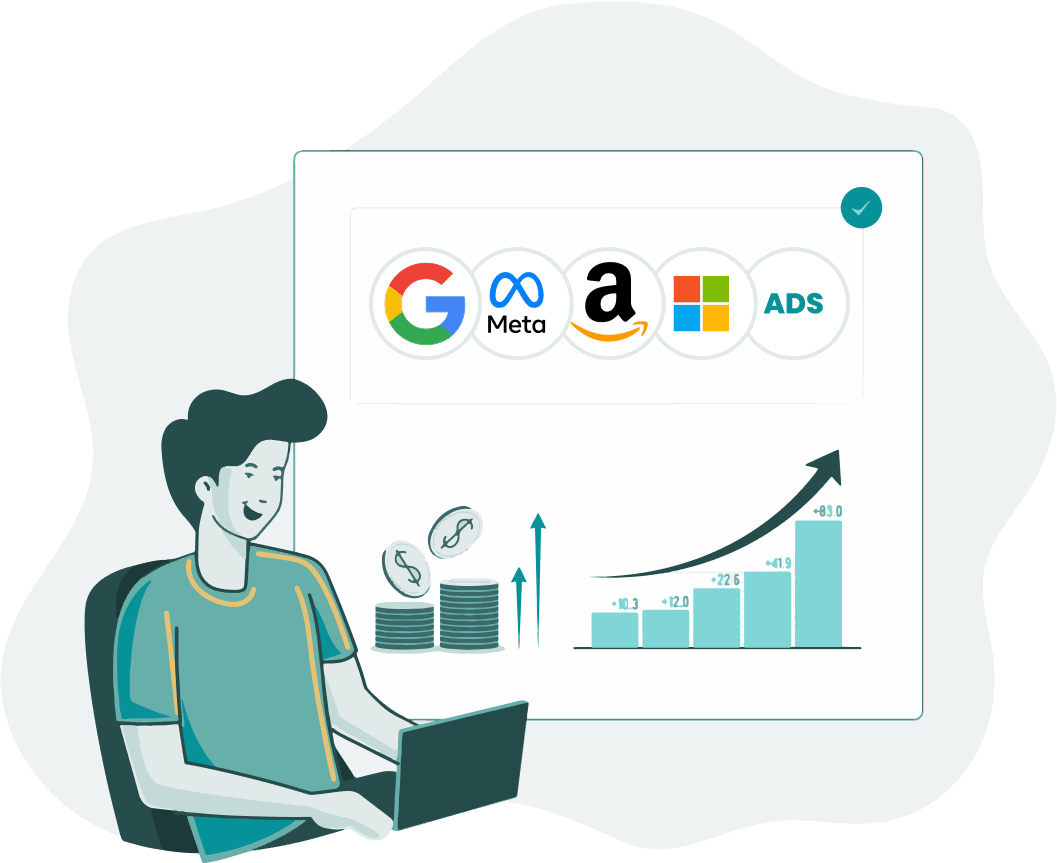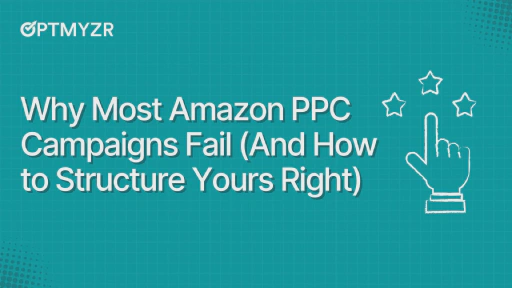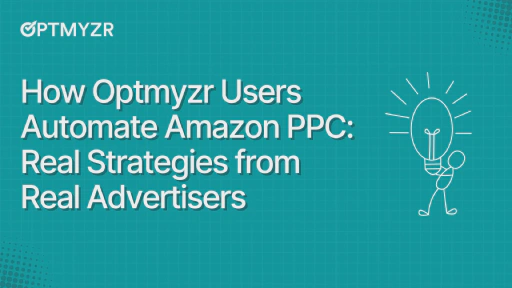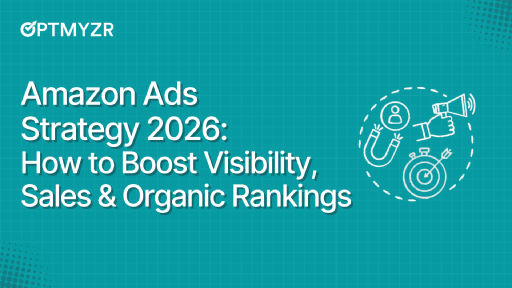Many advertisers invest significant time and effort into setting up Amazon ads, refining targeting, and monitoring performance metrics. Despite this, conversions can remain frustratingly low.
Often, the missing piece isn’t the ad strategy itself, but the product listings. While it’s easy to focus on ad optimization, the quality of a product listing plays a critical role in turning ad clicks into actual sales.
Elements like titles, images, bullet points, and A+ content might seem like minor details, but they directly influence click-through rates, relevance scores, and ultimately, conversions.
This article explores why listing quality deserves as much attention as advertising strategy and how strengthening it can drive better performance and more sales.
What you’ll learn in this guide:
- The connection between product listing quality and Amazon Ads performance
- How to craft better product titles, bullet points, and descriptions
- Why keyword research matters (and how to do it effectively)
- How to use A+ Content and images to boost conversion rates
- Tips for syncing listing optimization with campaign structure
- Common pitfalls to avoid (and how to fix them)
- Tools that can help speed up and scale your optimization efforts
The connection between listing quality and ad performance
Amazon’s algorithm evaluates both organic and paid placements as part of the same system.
This means the quality of the product listing affects not just organic search rankings, but also ad placement, CPCs, and ROAS.
Amazon uses a Product Listing Quality Score (PLQS) to rate your listing’s clarity, completeness, and relevance. It’s based on two things:
- How well listings are optimized
- How often shoppers view them
Better scores correlate to better visibility of paid and organic results.
How listing elements impact different advertising metrics
Main Image → Click-Through Rate (CTR)
Your main image drives clicks. If it’s blurry, cluttered, or doesn’t stand out, shoppers scroll past. That means you’re paying for impressions that don’t convert to visits.
📌Example: A blurry, poorly lit main image, or one that doesn't clearly show the product, will likely result in a lower CTR, even if the bids and keywords are strong. Shoppers will simply scroll past. |
Gallery Images, Bullets, A+ Content → Conversion Rate
Once shoppers land on your page, your gallery, bullet points, and A+ content need to close the sale. Weak visuals or vague info lead to hesitation and lost conversions (even if your ad targeting was perfect).
📌Example: If your gallery images don't show the product from multiple angles or in use, your bullet points are vague, and your description lacks detail, shoppers are less likely to convert, even if your ad attracted their initial click. This low conversion rate signals to Amazon that your ad traffic isn't leading to sales, potentially impacting future ad placements and overall ad performance. |
Keywords → Relevance Scores
Keywords in your title, bullets, and backend fields help Amazon match your product with the right searches. Stuffing keywords won’t help; relevance and intent alignment matter more.
Where bad listings drain your budget
The account might be bidding and targeting efficiently, but poor listings can still burn through ad spend. Here’s where most sellers lose money without realizing it:
- Paying for clicks that bounce: Even well-placed ads can fail if shoppers land on a confusing or underwhelming product page. Each bounce is a paid visit that goes nowhere
- Attracting the wrong audience: When listings lack precision, especially in keyword usage and messaging, you end up drawing clicks from people who were never a good fit
- Missing chances to build trust: If a brand is enrolled in Amazon Brand Registry but isn’t using Enhanced Brand Content (A+ Content), it’s missing out on the opportunity to add rich visuals, comparison charts, and detailed product storytelling to its listings. This extra content helps differentiate the brand, reduces purchase hesitation, and ultimately boosts conversions
- Lower future ad efficiency: Poor engagement metrics (like bounce rate and low conversion) signal to Amazon that listings underperform, which can increase CPCs over time
Start with competitor analysis
Even if your ads are already running, revisiting your competitors’ listings and ad strategies can highlight gaps in your own.
It’s especially useful if you’re seeing high click volume but poor conversions, signs that your competitors may be doing a better job aligning their listings with search intent.
1. Search top keywords on Amazon
Think like your customer. What exact phrases would they type to find your product? This is your opportunity to see who ranks organically and who’s actively paying for ads.
Note the brand names, keywords they used, and the overall presentation of their main images.
For example, a brand launching a 32L carry-on travel backpack would want to search for terms like ‘32L travel backpack’ or ‘carry-on travel backpack’ on Amazon.
Dive into both organic and sponsored listings to gather insights:
- Top organic results: Established brands like Nomatic, Samsonite, or Venture Pal may often be seen leading the way.
- Top ad results: The Sponsored Product spots may feature newer or lesser-known brands trying to secure the top positions.
💡What to look for:
|
2. Check “Customers also viewed” & “Compare with similar items”
Scroll down and check the “Customers Also Viewed” and “Compare with Similar Items” sections.
These sections show what else customers are seriously considering — they’re a shortcut to understanding their decision-making.
For the backpack, competitors like Osprey, Thule, or private-label sellers may appear.
Pay attention to highlighted features like expandable compartments, anti-theft zippers, or USB charging ports; these are likely important to the target audience.
💡What to look for:
|
3. See who’s bidding on your keywords
Pay attention to the sponsored ads for your keywords. These are the brands actively paying to get in front of your audience.
Are big brands defending their turf, or are new players trying to break in?
Also, observe how frequently brands appear. Daily visibility may mean solid budget backing. In-and-out appearances might suggest testing or limited spend.
💡What to look for:
|
4. Analyze their product listings
Now, dig into the nitty-gritty of competitors’ product pages. Start with their titles. Are they packing in high-ranking keywords like “airline-approved,” “water-resistant,” or “weekender”?
Titles are prime real estate. Make sure yours is packed with the right high-intent terms.
Next, check out their bullet points and descriptions. How do they position the benefits of their products? Are they focusing on comfort, durability, or something else?
This gives you a sense of what their audience values. Additionally, see if they are using A+ content for better visibility.
Check the type of visuals they are using as well. Are they using lifestyle shots (someone at an airport, packing for a trip) or sticking to white-background product photos?
Lastly, don’t skip the reviews. They give you a window into customer priorities, praise, and complaints
💡What to look for:
|
5. Monitor their ad activity over time
One search isn’t enough. Revisit your top competitors’ listings regularly (e.g., every few days for 2–3 weeks).
Track how frequently their ads show up and how their placements change. This helps you spot trends:
- Are brands investing long-term?
- Are they testing new creatives?
- Is seasonality playing a role?
Tracking this over time will help you get a sense of who’s really investing and who’s just dipping their toes in the water.
💡What to look for:
|
6. Study their video ads (if any)
If your competitors are running video ads, take a close look at them.
Video is a huge opportunity to connect with your audience, so pay attention to the style and pacing. Are they showcasing the product’s features, or are they telling a story?
Clear calls-to-action and real-life visuals usually do the heavy lifting. Think about how you could use these elements to position your product in a way that resonates.
💡What to look for:
|
7. Estimate their budget and ACoS
You can’t see your competitors’ exact ad spend, but you can make some pretty solid guesses based on how often their ads show up and what keywords they’re bidding on.
Start by checking the price point of their product. If they’re running lots of ads for a $30 item, their ACoS (Advertising Cost of Sale) needs to stay fairly low to stay profitable, which might mean they’re optimizing hard or have strong conversion rates.
💡What to look for:
|
If a brand keeps appearing for expensive keywords like “carry-on travel backpack” every time you search, chances are they’ve got a healthy budget or they’re laser-focused on dominating that niche.
Over time, tracking how often they show up can give you a decent estimate of who’s really investing in ads (and who might be easier to outbid).
💡Optmyzr Tip: Run the Advertised Products Not Delivering audit in Optmyzr that highlights SKUs that are receiving ad spend but not converting, to spot where your ads are showing up and costing you without generating results. |
8. Organize your findings in a spreadsheet
All these insights are only helpful if you can keep track of them. Create a simple spreadsheet to compare competitors side-by-side. Here’s what to include:
- Competitor names and ASINs: So you can quickly revisit their listings and track changes over time
- Key products and price points: What are their best-selling or most visible items? How are they priced compared to yours?
- Primary keywords they target: Which search terms consistently trigger their ads or organic placements?
- Unique selling propositions (USPs): What do they emphasize: durability, style, features, eco-friendliness?
- Ad types they use most: Are they relying on Sponsored Products, Sponsored Brands, or video ads?
- Estimated ad spend: Based on frequency of ads and keyword competition (You won’t get exact numbers, but rough guesses help.)
- Strengths and weaknesses: Where do they shine, and where could you do better? Maybe they have great lifestyle images, but weak bullet points
9. Tips for putting your research into action
Now that you’ve done the research, here’s how to turn it into action:
- Test before you go all-in: If you spot something clever in a competitor’s ad strategy, don’t blindly copy it. Run a small campaign to see if it actually works for your product and audience.
- Look for gaps they’re missing: Sometimes the best opportunities are where others aren’t looking. Find keywords that still get searches but don’t have a lot of competition and claim that space.
- Lean into what makes your product better: Don’t just blend in. If you offer something competitors don’t (better warranty, more durable material, simpler design), make it loud and clear in your ads and listings.
- Be strategic with your bids: You don’t need to outspend everyone. Just make sure you’re bidding smart on the keywords that matter most for your conversions.
- Use their weak spots to your advantage: If other listings are vague or missing reviews, make your copy sharp and specific. Highlight trust signals like customer testimonials, guarantees, or certifications.
- Stay flexible with your budget: If big brands are flooding the space, you may need to invest more to compete or get creative and focus on angles they’re ignoring.
Optimizing titles
Your product title is one of the most important elements Amazon uses to rank and display your listing. It’s also one of the first things shoppers see, so it needs to be both keyword-rich and customer-friendly.
Each category has specific title length limits (typically around 200 characters including spaces, but some are lower). Yet, it’s recommended to keep your title under 80 characters.
Here are some more guidelines to optimize your titles:
- Place your primary and most relevant keywords at the beginning of the title
- Avoid creating keyword fluff by repeating primary keywords or their synonyms
- Use numerals instead of spelling out numbers (e.g., pack of 2)
- Avoid adding subjective commentary like bestseller, customer favorite, hot selling, etc.
- Add information related to size and color variants in the child ASIN (not the product ASIN)
For example, here’s a title that breaks all of these rules:
❌ Bestselling Airtight Kitchen Food Storage Container – Hot Selling Premium Quality Plastic Food Keeper Set – Pack of Three – Clear Color – Must-Have Storage Solution |
- It repeats similar phrases like “Food Storage Container,” “Food Keeper,” and “Storage Solution”
- It includes hype words like “Bestselling,” “Hot Selling,” and “Must-Have”
- It spells out the number “Three” instead of using “3”
- It mentions “Clear Color,” which should only appear in the child ASIN
- The primary keyword isn’t placed at the front
A better version that follows all the guidelines would be:
✅Airtight Food Storage Container Set – Pack of 3, BPA-Free Plastic, Stackable |
- The keyword is placed at the beginning
- No repetition or unnecessary synonyms
- Numerals are used
- No subjective terms
- Variant info, like color, is left for the child ASIN
How to find the right keywords for your titles
Before you even write your title, you need to know which keywords your customers are actually using and, just as importantly, which ones to avoid.
A good starting point is to:
- Look at top-ranking listings for your main product terms and note the keyword patterns they use
- Use tools like Amazon’s Search Term Report (via Sponsored Products) to see what queries are already bringing traffic
- Explore autocomplete suggestions in the Amazon search bar to see real-time popular phrases
- Pay attention to reviews and competitor A+ content to catch recurring language customers use organically
💡Optmyzr Tip: Once you’ve gathered potential keywords, the next challenge is filtering out the ones that attract clicks but don’t convert. Optmyzr’s Negative Keyword Finder tool helps surface irrelevant or low-converting queries. These insights can help you avoid stuffing your titles with broad or misleading terms while ensuring your keywords aren't dragging down ROAS. |
Using bullet points
Bullet points do more than just list out features; they work in two key ways.
First, they help shoppers quickly see what your product offers, which can lead to more sales.
Second, bullet points give you a natural place to work in relevant keywords. When written well, they improve your visibility without feeling forced.
So they’re not just helpful for people, they’re helpful for algorithms too.
To make the most of your bullet points, follow this structure for high-converting results:
- Keep formatting and length consistent: When your bullets are roughly the same length and follow a consistent format, shoppers are more likely to read through them instead of skipping.
- Use all available bullet points: Amazon gives sellers 5 and vendors 10 bullets. Each bullet is an opportunity to add value, address concerns, or highlight use cases that resonate with different types of buyers.
- Lead with benefits, follow with features: Think like a shopper. Instead of saying, “Made with stainless steel,” say, “Rust-resistant and built to last- made with durable stainless steel.” The benefit captures attention; the feature supports it.
- Avoid keyword repetition: Repeating the same phrases wastes space and doesn’t help with ranking. Instead, spread out your keyword targeting by using related terms and phrases across different bullets.
Image optimization
Your product images aren’t just decorative, they directly impact how many people click on your listing in search results and ads.
The critical role of the main image in ad CTR
The main image is the first thing shoppers see when your product appears in search results or Sponsored Product ads. It’s what gets them to slow down, take notice, and click.
A compelling, high-quality main image can significantly improve your click-through rate (CTR), which in turn feeds into your ad performance and organic rankings.
If your image is unclear, too zoomed out, or doesn’t stand out visually, your listing is more likely to be ignored (even if your product is great).
What makes an effective main image?
If you’re wondering whether your main image is doing its job, ask yourself these questions:
👉Is the background pure white?
Amazon requires a true white background (#FFFFFF) to keep listings clean and consistent. This also helps your product stand out in search results.
👉Does the product fill the frame correctly?
Aim for about 85% of the frame; big enough to show detail, but not so large that it gets cropped or looks awkward. Is your product too small or too zoomed in?
👉Are the colors and contrast accurate?
Good lighting should bring out the product’s true color and texture. Is the product clearly visible, or do shadows and low contrast make it look dull?
👉Is there anything extra in the image?
The main image should be clean; no text, logos, badges, or extra props. Those elements can go in your secondary images, where you have more creative flexibility.
Gallery images best practices
Your main image grabs attention, but gallery images help seal the deal. They give shoppers a deeper look at what your product can do and how it fits into their lives.
Here are some simple tips to make your gallery images work harder👇
Lifestyle images showing use cases: People want to see how your product fits into their daily life. Instead of just showing the product on its own, show it being used in real situations.
For example, say someone searches for “waterproof earbuds for swimming.” To resonate deeply with the researcher, here’s an image that will work:
- Infographics for key features: Sometimes, words can’t do the product justice. Infographics are great for highlighting standout features quickly and clearly. You can use them to explain things like durability, functionality, or what makes your product unique.
- Size/dimension references: Size is one of the biggest questions shoppers have. A simple image showing your product next to a common item (like a coffee cup or a piece of furniture) or with clear dimensions helps them understand exactly what they’re buying.
- Before/after demonstrations: If your product promises results, like a cleaning product or a beauty tool, before-and-after shots are incredibly powerful. It’s one of the best ways to prove your product works and build trust with potential buyers.
- Text overlays with consistent branding: Gallery images are a great place to add text overlays, but keep them minimal and consistent. Whether it’s highlighting a special feature or reinforcing your brand, make sure your text style and tone match the rest of your listing.
A+ Content
A+ Content goes beyond the basics to tell your product or brand story in a more engaging, visual way.
High-quality visuals and clean layouts grab attention faster than plain text.
You can proactively address common customer concerns and questions through dedicated modules within your A+ content.
Why A+ content sells
Here’s how A+ Content helps you sell more:
- It grabs attention: Bold visuals and clean design stand out more than plain text and keep shoppers engaged.
- It explains your product better: Highlight key features and help shoppers understand how your product solves a problem or fits into their lives.
- It builds trust: Professional, polished content gives your brand credibility and shoppers the confidence to make a purchase.
- It answers common questions: Use your A+ modules to proactively address common hesitations and reduce drop-off.
- It looks great on mobile: A+ Content is built to work on small screens, too, which is important for shoppers browsing and buying through mobile devices
- It tells your story: Don’t just list features; tell people why your brand exists, what makes you different, and why they should choose you.
What makes A+ content really work?
If you want your A+ Content to truly drive conversions, keep these pointers in mind:
👉Stick to a clean, consistent look. Match your brand’s colors, fonts, and tone. Keep the design simple and easy to follow. You don’t want a cluttered layout getting in the way of your message.
👉Use comparison charts. If you have similar products or different models, a side-by-side chart helps shoppers quickly spot the differences. It makes decisions easier and quicker.
👉Add lifestyle photos. Show your product in action. Whether it’s a kitchen gadget in a real kitchen or a beauty product in a daily routine, these images help people picture themselves using it.
👉Highlight real problems (and how you solve them). Think about what pain points your product solves. Show the “before and after.” Make it obvious how your product makes life easier or better.
👉Include subtle social proof. While you can’t repost customer reviews, you can mention awards, recognition, or even use callouts like “trusted by thousands” (as long as it’s true and within Amazon’s guidelines). It helps reassure new buyers that they’re making a smart choice.
Monitoring and optimization
Listings need consistent oversight to maintain strong performance. Here’s how to build a reliable system for monitoring and improving them:
Track changes and their impact
Document all listing updates, including titles, images, descriptions, keywords, and monitor the effect on performance metrics like impressions, clicks, CTR, and conversions.
💡Optmyzr Tip: Set up KPI and Budget alerts for Amazon ads that can notify you when key metrics like CTR, ROAS, or ACoS change significantly, so you know when it’s time to investigate or revert a tweak. |
Run regular audits
You don’t want to wait until something’s broken to look for issues. Set aside time every couple of weeks to run a full audit of your account.
This will help you catch underperforming campaigns or missed opportunities before they add up.
Optmyzr offers a solid set of Amazon audits you can use to dig deep. These audits cover everything from:
- Campaign performance: Are any of your campaigns running below target ROAS, or not spending their full daily budget?
- Ad groups: Check for ad groups that have too many keywords or not enough, so you can optimize targeting.
- Keywords: Identify expensive keywords that aren’t converting, or low-CTR terms that might need tweaking.
- Products: Get visibility into ASINs that aren’t showing up in campaigns or performing poorly.
- Placements and audiences: See which placements and audience targeting are driving the most engagement and conversions.
Running these audits regularly helps you make sure everything’s working together to drive results.
Stay on top of seasonal shifts
Seasonality can have a huge impact on keyword performance. Things like Black Friday, Prime Day, or back-to-school sales can shift how consumers search for products.
Track keyword trends and be ready to adjust your bidding and targeting strategies accordingly.
💡Optmyzr Tip: Seasonal performance changes demand agile bidding. Optmyzr’s pre-built strategies for Amazon ads like Set Bids to Reach Target ACoS lets you realign bids based on how well your newly optimized listings are converting during peak seasons. |
Keep an eye on competitors
Competitors are constantly adjusting their strategies, too. Take note of their listing updates, like new images or updated keywords, and see how it impacts their performance.
If they’re gaining traction, maybe it’s time to tweak your listings or adjust your ad strategy to stay competitive.
Better listings power better ads
Optimizing your Amazon ads goes far beyond adjusting bids. More often than not, the real issue is what happens after the click. Weak images, vague bullet points, or unclear value props quietly chip away at your conversions and your budget.
That’s why it pays to keep a close eye on your listings, not just your campaign settings.
Optmyzr helps you spot where things are falling through the cracks, like which products are eating up spend without selling, or which keywords bring in traffic but not results.
Want to see how it can help? Sign up for a fully functional 14-day trial today!









